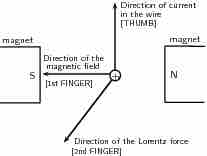The basic principles of operation for a motor are the same as those for a generator, except that a motor converts electrical energy into mechanical energy (motion). (Read our atom on electric generators first. ) Most electric motors use the interaction of magnetic fields and current-carrying conductors to generate force. Electric motors are found in applications as diverse as industrial fans, blowers and pumps, machine tools, household appliances, power tools, and disk drives.
Lorentz Force
If you were to place a moving charged particle in a magnetic field, it would experience a force called the Lorentz force:
where v is the speed of the moving charge, q is the charge, and B is the magnetic field. Current in a conductor consists of moving charges. Therefore, a current-carrying coil in a magnetic field will also feel the Lorentz force. For a straight current carrying wire that is not moving, the Lorentz force is:
where F is the force (in newtons, N), I is the current in the wire (in amperes, A), L is the length of the wire that is in the magnetic field (in m), and B is the magnetic field strength (in teslas, T). The direction of the Lorentz force is perpendicular to both the direction of the flow of current and the magnetic field and can be found using the right-hand rule, shown in . Using your right hand, point your thumb in the direction of the current, and point your first finger in the direction of the magnetic field. Your third finger will now be pointing in the direction of the force.

Right-Hand Rule
Right-hand rule showing the direction of the Lorentz force
Mechanics of a Motor
Both motors and generators can be explained in terms of a coil that rotates in a magnetic field. In a generator the coil is attached to an external circuit that is then turned. This results in a changing flux, which induces an electromagnetic field. In a motor, a current-carrying coil in a magnetic field experiences a force on both sides of the coil, which creates a twisting force (called a torque) that makes it turn . Any coil carrying current can feel a force in a magnetic field. This force is the Lorentz force on the moving charges in the conductor. The force on opposite sides of the coil will be in opposite directions because the charges are moving in opposite directions. This means the coil will rotate.

Torque
The force on opposite sides of the coil will be in opposite directions because the charges are moving in opposite directions. This means the coil will rotate.